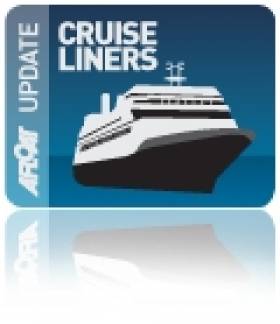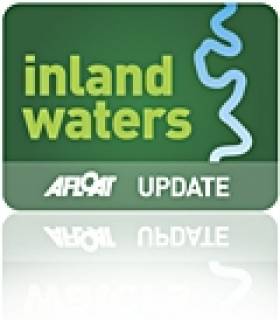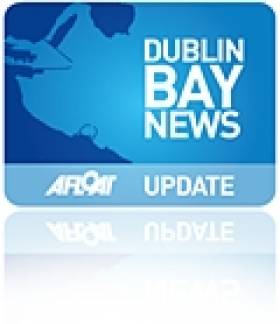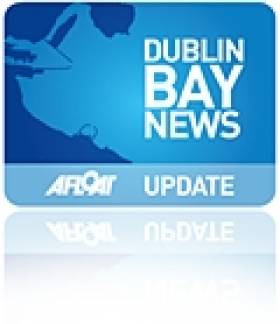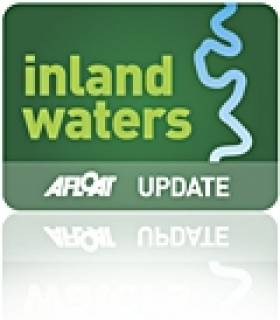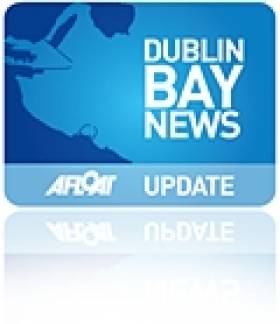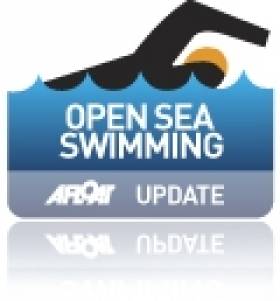Displaying items by tag: Dublin City Council
€220m for 9km Pipeline to Cut Dublin Bay Pollution
Dublin City Council is proposing a mammoth 9km sewage outfall pipe to help make Dublin Bay cleaner - at a cost of €220m.
Herald.ie reports that the 5m-wide pipe - longer than the Dublin Port Tunnel - would dump effluent from the Ringsend treatment plant far offshore, thereby avoiding pollution in the bay and sensitive areas such as Bull Island, which recently lost its EU Blue Flag status for Dollymount Strand.
Plans for the project, which DCC head of waste Pat Cronin described as the "greenest and most economic solution" will be open to public consultation in the near future, with a timetable for completion by 2015.
The pipeline and redeveloped treatment plant will be funded via the Department of the Environment's water services investment programme.
Largest Vessel Transits Samuel Beckett Swing-Bridge
She remained alongside this berth which is normally used by large commercial ships until the vessel sought a berth much closer to the city-centre. This led to a shift of berths in the evening when the 2003 built vessel headed upriver to the Dublin City Moorings facility at Custom House Quay, but this firstly required transiting through two bridges.
With a beam of 10.6m Fortunate Sun entered through the East-Link toll-lift bridge followed by the Samuel Beckett bridge, the Liffey's newest crossing point which opened in late 2009. The €60m bridge was commissioned by Dublin City Council and designed by the Spanish architect engineer Santiago Calatrava. To read more on the bridge click HERE.
Fortunate Sun is registered in the Caymen Islands and is capable of over 17 knots on a range of 5000 nautical miles. She has a steel hull and an aluminium superstructure and interiors also by Tim Heywood Design. In the early hours of tomorrow morning the vessel built by Oceanfast is to depart through the 5,700 tonnes bridge which was delivered by barge after a five-day voyage from Rotterdam.
There has been previous transits of the bridge notably the annual Dublin Rally organised by the the Inland Waterways Association of Ireland (IWAI). This year's Dublin Rally took place on 1 May when boats travelling on the Royal Canal descended via Croke Park and entered the Liffey at Spencer Dock. This required the Iarnrod Éireann bridge-lift and the water level in Spencer Dock to be lowered so to allow safe clearance under the Sheriff St. bridge.
From there the IWAI flotilla made the short passage downriver to re-enter another inland waterway system at the Grand Canal Dock, marking where the Liffey connects with the city's southern canal. The 2011 Dublin Rally was the first time since 1955 that boats could enter Dublin from the Shannon via the Royal Canal and the first time since 2004 that boats also joined from the Royal Canal.
- powerboats
- motorboats
- inland waterways
- Dublin Port
- Dublin
- Grand Canal
- IWAI
- Royal Canal
- DDDA
- Inland Waterways Association of Ireland
- Dublin City Council
- Spencer Dock
- River Liffey
- Ports and Shipping News
- EastLink Toll Bridge
- Dublin Port news
- Grand Canal Dock
- Dublin Docklands Development Authority
- M.Y. Fortunate Sun
- Tim Heywood Design
- Lifffey
- Dublin City Moorings
- Custom House Dock
- Powerboat news
- Motoryachts
- Sir John Rogerson Quay
- Inland Waterways news
- Dublin Rally
- Ianrod Eireann
- Oceanfast
- Scottish Western Isles
Spot the ‘Big’ Difference! From Containership to Cruiseship
It may just be another cruiseship visiting Dublin Port today, but the gleaming white painted Costa Marina started her career in complete constrast as a grey-hulled containership, writes Jehan Ashmore.
The cruiseship has some unusual hull design features indicating clues to her origins as the containership Axel Johnson (click PHOTO) notably the pronounced chine bow (horizontal-lines) still clearly visible under her name when launched in 1969 at the Oy Wärtsilä shipyard in Turku, Finland.
She was the leadship of five sisters of over 15,000 tonnes ordered by her Swedish owners, Johnson Line. The next sister completed, Annie Johnson was also converted into a cruiseship and she too serves Costa Cruises as their Costa Allegra.
Axel Johnson measured 174m in length and was fitted with two deck-mounted gantry-cranes to handle containers. Her design even catered for passengers but was limited to just four-persons compared to today near 800 passenger capacity and an increase in tonnage to 25,500. To see how she looks now click PHOTO
Her Scandinavian owners sold the vessel in 1986 though it was not until 1988 that the containership came into the ownership of her current owners Costa Cruises who converted the vessel at the Mariotti Shipyard in Genoa. Two years later the ship emerged as the Costa Marina (to see another click HERE).
She has nine decks which feature restaurants, bars, jacuzzis, pools, gym, treatment rooms, sauna, an outdoor jogging track, theatre, casino, disco and a squok club with PlayStation entertainment. Accommodation comprises for 383 cabins including 8 suites with private balcony and a crew close to 400.
Costa Cruises were founded in 1924 but they are a relative newcomer to Dublin. The vessel departs this evening from Ocean Pier bound for the Icelandic capital of Reykjavik. To view the ship's web-cam click HERE (noting to scroll right down the page).
Costa Marina and indeed larger cruiseships may in the future relocate upriver to berths much closer to the city-centre, should proposals by Dublin City Council take pace. In order to boost tourism numbers a dedicated new cruiseship terminal could be built at a site close to the O2 Arena and East-Link bridge.
The site at North Wall Quay Extension is currently in use by ferry operator P&O (Irish Sea) for their ro-ro route to Liverpool. To read more in a report in yesterday's Irish Times click HERE.
Grand Canal Dredging Begins This Month
Waterways Ireland has confirmed that further dredging of the Grand Canal in Dublin will commence this month and continue till the end of April on the inland waterway.
The canal will be closed to navigation from Lock C4 at Baggot Street to Lock 1 at Suir Road for the removal of sediment and rubbish between Mespil Road and Portobello Harbour, making the canal navigable for a large range of boats.
Traffic management plans have been agreed with Dublin City Council to keep disruption to a minimum, and discussions have taken place with the National Parks and Wildlife Service on measures to minimise the impact on sensitive habitats along the canal.
Dublin Bay Oil, Gas, Coal...and Waste-Water!
The work is part of a Dublin City Council project to evaluate an extension at the Ringsend plant where treated water will be released into the bay. The council are conducting detailed feasibility studies which will be examined for an Environmental Impact Assessment.
To date the project has involved two other rigs, the Aran 250 and the larger Excalibur which remains in the bay. The barges will be towed to 20 pre-determined bore-hole locations in the bay where the jack-up rig barges operate 'legs' to sit on the seabed which enables a steady working platform. The rigs are operating on a continuous basis in an area covering most of Dublin Bay and close to the Burford Bank on the eastern fringes.
In addition a buoy will be positioned 300-metres of the barge during drill operations, which is expected to take approximately one week for each drill. For information on the location of the bore-holes, they can viewed from the Dublin Port website by clicking HERE The project is expected to be completed in late Spring.
Several support craft are engaged in the project that recently included the Seabed Worker, a 3,923 gross tonnes Norwegian anchor-handling tug supply vessel (AHTS) the tugs Multratug 7, MTS Valiant and Trojan and the RIB-craft sisters, Brian Boru and James Joyce which are on standby duties. Like the Trojan, the 12-seater RIBS are based at the Poolbeg Yacht Club Marina where in the tourist season the craft provide excursions in Dublin Bay for Sea Safari Tours. In October the project also required the services of the yellow-hulled catamaran, Xplorer to carry out a bathymetric survey of Dublin Bay. The larger tugs and rigs are based opposite in Alexandra Basin / Ocean Pier.
The largest drill-rig working to date on the project, the Excalibur arrived under the tow of the Multratug 7 on a misty morning on Christmas Day. Due to the weather conditions the red-hulled craft slipped quietly into the port. Several days later the imposing looking craft re-emerged with its six-towering jack-up 'sea-legs' that jutted skywards into an otherwise horizontal expanse of Dublin Bay.
The sight of the rig has presented many onlookers to mistakenly believe the drilling was for oil!...Not so but the assumption is not surprising given the reports last year of an oil-field discovery named the Dalkey Island Prospect. The name for the oil-field was referred to Dalkey, as the coastal suburb on the southern shores is the nearest landfall to the exploratory well sites at the Kish Bank Basin.
In fact this kind of exploratory activity was again to confuse residents throughout the bay when the drill-ship, Fugro Synergy was offshore at the Kish Bank between December 2009 and early Spring of 2010. Though on this occasion the search was not for oil but coal!
During this period the 5,200 tonnes vessel equipped with a drill-tower, seemed to be a near permanent feature on the horizon. A series of drill-wells up to 3,500-metres were conducted when the 2009 built ship was contracted to Irish based VP Power Ltd, to determine the commercial viability of extracting coal from the sea for generating electricity. The Underground Coal Gasification (UCG) project is a process where coal is heated in underwater rock reservoirs to extract gas, essentially converting gas-from-coal energy. Otherwise this method is commonly referred to as a 'clean' technology.
In addition to last year's search for deposits of large coal seams under the seabed, there was reports of a significant natural resource in the form of oil!... when several exploratory blocks again in the Kish Bank Basin were surveyed. The company behind this venture, Provident Resources, another Irish based exploration company, conducted initial oil surveys using air-born craft and as such no actual drill-based ships or rigs were used. Though should any oil flow, such an operation would be required.
Incidentally the Excalibur is designed also to perform offshore wind turbine installation work and is equipped with a 250-ton crane to hoist the wind-farm components. The vessel is operated by Fugro Seacore, a subsidiary of the Dutch parent company, Fugro, which also managed the drill-ship Fugro Synergy.
Jack up Barge Arrives on Dublin Bay
These jack-up barges will be used for the drilling of test boreholes at various locations within Dublin Bay and its approaches. Initially, the "Aran 250" will be used and it is expected that under normal conditions it will operate on a 24 hour / 7 day week basis.
At all times when the jack-up barge is on location it will transmit an "AIS" signal. By night the barge will display white lights (operated in unison) flashing Morse code (U) every 15 seconds. These will be located at each corner. The barge itself will be lit by operational deck lights.
When the jack-up barge is operational it will have the standby boat "James Joyce" with two people on board in attendance. They will tie-up to a buoy moored approximately 300 metres away from the barge. The small tug "Trojan" will operate as a supply boat and will be based at the Poolbeg Marina. The Trojan will also be used for towing the barge from one location to the next.
The test borehole drilling positions (WGS 84) are as follows :-
M06 Lat 53˚ 19' 53.46'' N Long 006˚ 09' 39.08'' W M15 Lat 53˚ 19' 11.35'' N Long 006˚ 06' 58.16'' W
M07 Lat 53˚ 19' 11.27'' N Long 006˚ 08' 21.42'' W M16 Lat 53˚ 18' 32.75'' N Long 006˚ 06' 33.07'' W
M08 Lat 53˚ 19' 50.64'' N Long 006˚ 06' 21.73'' W M17 Lat 53˚ 20' 23.37'' N Long 006˚ 05' 16.93'' W
M09 Lat 53˚ 18' 38.17'' N Long 006˚ 05' 45.02'' W M18 Lat 53˚ 19' 32.50'' N Long 006˚ 05' 19.69'' W
M10 Lat 53˚ 17' 44.38'' N Long 006˚ 03' 41.33'' W M19 Lat 53˚ 18' 16.91'' N Long 006˚ 05' 02.71'' W
M11 Lat 53˚ 19' 42.31'' N Long 006˚ 03' 22.31'' W M20 Lat 53˚ 17' 51.94'' N Long 006˚ 04' 43.04'' W
M12 Lat 53˚ 19' 00.03'' N Long 006˚ 00' 25.74'' W M21 Lat 53˚ 18' 56.68'' N Long 006˚ 04' 07.12'' W
M13 Lat 53˚ 19' 51.50'' N Long 006˚ 10' 13.42'' W M22 Lat 53˚ 19' 09.75'' N Long 006˚ 02' 37.54'' W
M14 Lat 53˚ 19' 59.29'' N Long 006˚ 07' 53.39'' W M23 Lat 53˚ 18' 48.98'' N Long 005˚ 59' 07.97'' W
Each location will take approximately 1 week to drill. Drilling will not follow in sequence listed above. VTS will keep all shipping advised with regards to the location at which the barge is operating.
More detail is contained in a marine notice issued by Dublin Port Company's
Harbour Master, Captain David T. Dignam HERE
Lightship To Lead A Rocky Life?
The Dublin 'Docklands' developer, Harry Crosbie is seeking permission from Dublin City Council to raise the 500-ton lightship, Kittiwake and place on the quayside opposite The 02 Theatre. Currently the lightship is berthed nearby the East-Link road toll bridge and acts as a notable floating feature to countless daily commuters.
In 2007, the Commissioners of Irish Lights (CIL) sold the 1959 built lightship to Crosbie. The 134-foot lightship had served in that role for many years around the Irish coast. In 1981, as part of an extensive modernisation programme, the Kittiwake and other lightships were converted into an automated light-float (ALF). The last station served by the ALF was at South Rock, Co. Down.
If the former lightship is given the green light, the vessel would act as a "welcoming point" for cruise tourists. Subject to planning permission, the lightship would undergo another re-conversion project to create an open-plan café bar for a period of five years.
The veteran vessel would also have its lighthouse light restored and would "beam" across the docklands and entertainment venue. The lightship would maintain its customary 'red' hull with Kittiwake written in neon on the side.
In order to attract this cruise business to the Kittiwake, Crosbie has asked the Dublin Port Company to relocate the main existing cruise-ship location closer to the O2 Theatre. The proposal has the support of Dublin City Council.
In the meantime the majority of cruise-ships dock at Alexandra Basin, in the heart of the port's industrial zone but the distance is quite far from there to the city centre.
On an annual the capital welcomes around 80,000 passengers during each season, generally between May to October. In 2011, the port expects 86 cruise-calls, potentially generating €35m to €55m to the economy.
The proposed for the new terminal is to be submitted to the EU this month, in the hope of financing support. Meanwhile the proposed site envisaged for the cruise terminal, is occupied by tugs based operated by Dublin Port Company.
Dublin Canal Developments Approved
The Minister for Community, Equality and Gaeltacht Affairs, Pat Carey T.D., today announced the approval of the granting of leases for a number of proposed developments on Dublin's canals on the inland waterways.
The developments include the construction of a cycle bridge across the Royal Canal at Spencer Dock, a boardwalk along the Grand Canal at Leeson Street and a pedestrian/cycle bridge across the Grand Canal at Lynches Lane.
The decision to grant leases to Dublin City Council and South Dublin County Council for the proposed developments was taken at a meeting of the North South Ministerial Council in Armagh this morning. Speaking after the meeting, Minister Carey said the decision to approve the leases had the potential to further transform Dublin's waterways for the benefit of the citizens of Dublin.
Minister Carey said, "Developments like those proposed by Dublin City Council will add to the regeneration of the city and will strengthen the environmental, social and economic fabric of the capital. They will add to the quality of life of all and especially to the quality of life of pedestrians and cyclists."
John Martin, Chief Executive of Waterways Ireland, the cross-border body charged with the all-island promotion and development of waterways is delighted that the Ministers have approved the granting of the leases at the NSMC.
He said "Waterways Ireland is happy to facilitate the development of these waterside amenities in the Dublin Area. We hope to work with all the local authorities on many projects in the future right across the Dublin Region."
Drilling of Test Boreholes in Dublin Bay
The barge is contracted to Dublin City Council for the drilling of test boreholes in the approaches to and within Dublin Bay in relation to the Ringsend Wastewater Treatment Plant. Both jack-up barges 'Aran 250' and 'Excalibur' will be operating on a 24-hour / 7 days per week basis.
In attendence Sea Safari Tours RIB 'James Joyce', which normally operates as a tourist-sightseeing craft will act as a stanby boat during the rig operations. In addition a buoy will be positioned 300-metres of the barge during drill operations, which is expected to take approximately one week for each drill.
The project will also see the tug, Trojan providing supplies and to tow the jack-up rigs between locations in Dublin Bay. Both the James Joyce and the Trojan will be based out of the Poolbeg Marina, in the centre of the port.
Since the start of October, the project has also required the services of the yellow-hulled catamaran, Xplorer to carry out a bathymetric survey of Dublin Bay.
For further detailed information, please consult Notices to Mariners (No. 14 and 15) listed on the Dublin Port Company website by logging onto this link: http://www.dublinport.ie/information-centre/notice-to-mariners/
In addition to www.dublincity.ie
Brian O'Dwyer Wins Liffey Swim (Results HERE)
The 90th annual Dublin Liffey Swim sponsored by Dublin City Council took place today, Saturday 11th September 2010. The swim, a 2.2kilometre race, started at Watling Street Bridge and finished at the Customs House. The swimmers were each assigned a time handicap depending on their level of proficiency.
Dublin City Council's 90th Liffey Swim Race 11th September 2010 - Men's & Women's Results
Men's Event – 13.30hrs Start
Winner - Brian O'Dwyer, Guinness Club (no handicap).
Second place - Terry Joyce, Eastern Bay Club (no handicap).
Third place - Vinnie Nicoletti, Guinness Club (no handicap).
Women's Event – 14.15hrs Start
Winner - Deirdre Dunne, St. Vincents Club (handicap 45 seconds).
Second place - Maeve Dunne (no handicap).
Third place - Susan Ritchie, Tallaght Masters Club (no handicap).



